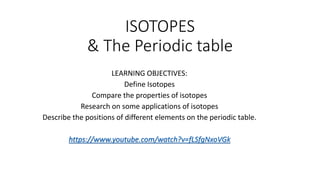
ISOTOPES.pptx
- 1. ISOTOPES & The Periodic table LEARNING OBJECTIVES: Define Isotopes Compare the properties of isotopes Research on some applications of isotopes Describe the positions of different elements on the periodic table. https://www.youtube.com/watch?v=fLSfgNxoVGk
- 2. Alkali metals • Alkaline metals : belong to the first Vertical column - GROUP 1 • Carefully observe the video • https://www.youtube.com/watch?v=6ZY6d6jrq-0 • Predict some general properties of this Group • How many valence electrons do they have? ____________ • Whom do they quickly react with? _____________ • As we move down a group it is seen that the _____________________ increases
- 3. Alkaline earth metals • Alkaline metals : belong to the first Vertical column - GROUP 2 Carefully observe the video • https://www.youtube.com/watch?v=Q_8OVgEDu8s • Predict some general properties of this Group • How many valence electrons do they have? ____________ • Are they more reactive than Alkali metals? _____________ • As we move down a group it is seen that the _____________________ increases
- 4. Noble gases • Noble gases: belong to the last Vertical column - GROUP 8 Carefully observe the video • https://www.youtube.com/watch?v=g3xBsqAU39c • Predict some general properties of this Group • How many valence electrons do they have? ____________ • Are they reactive ? _____________
- 5. Properties of a Group • All elements in the same group have same outer electronic configurations so have similar chemical properties. • They all have the same valency. • If the properties of 1 element in the group is known , then we can predict the properties of all other elements on the group. • As we move down a group , the no of electronic shells increases. Properties of a Period • On moving from left to right of the period all elements have increasing atomic numbers . • Electrons are added to the same shell. • On moving from left to right of the period, the metallic properties decrease and non-metallic properties increase.
- 6. General properties • Properties of elements repeat at regular intervals • Hence called periodic table. • The elements are arranged on the basis of their increasing atomic numbers. • Metals ( alkali and alkaline earth metals ) are placed on the extreme left of the table. • Transition metals are placed at the center of the table. • Non-metals are placed on the right hand corner of the table. • Noble gases are placed to the extreme right of the table.
- 7. Metalloids • Metalloids: show prpoperties of both metals and non metals • https://www.youtube.com/watch?v=TcvMroyYaW0 • Predict some general properties of this Group • How many valence electrons do they have? ____________ • Are they reactive ? _____________
- 8. Halogens • Halogens: belong to the second last Vertical column - GROUP 7 Carefully observe the video • https://www.youtube.com/watch?v=HT1zAPQIBAQ • https://www.youtube.com/watch?v=u2ogMUDBaf4 • Predict some general properties of this Group • How many valence electrons do they have? ____________ • How many electrons do they need to become stable ? ____________ • Are they reactive ? _____________